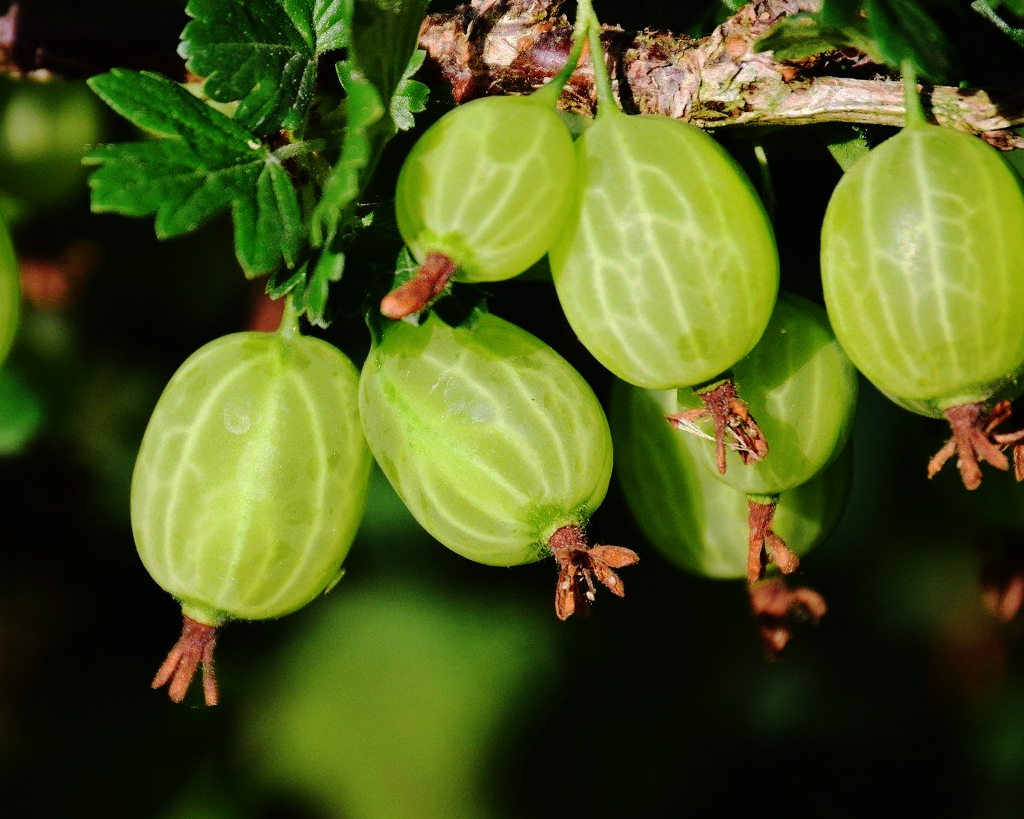Gooseberry is one of those berries that can be called a “classic” of gardening. Its sweet and sour fruits, which resemble grapes in taste, are popular with both children and adults. And how many things can be prepared from it: jam, compotes, jams, marmalade, sauces for meat… But to get a good harvest, you need to know how to properly plant this crop, take care of it and protect it from diseases and pests. Let’s analyze everything in order so that your bush grows healthy and pleases you with abundant fruiting.
At the end you can download a brochure in which you’ll find a decision checklist, spacing and planting steps, watering and feeding rules, pruning and training for productive spurs, a seasonal calendar, propagation methods, and a small bush-planning worksheet.
The benefits of gooseberry
Before we dive into practical recommendations, let’s discuss why you should consider planting gooseberry. After all, this berry is not just delicious, but also incredibly useful! The composition of gooseberry contains a whole army of vitamins, including C, A and the entire group B. Minerals are also present in abundance: potassium, magnesium, iron-all this works for the benefit of the body. It is rich in antioxidants that protect cells from damage and slow down the aging process.
As for the impact on health, gooseberry also have something to brag about. It strengthens the immune system, helping the body resist viruses and infections. If someone has digestive problems, it can be an ally: it stimulates the gastrointestinal tract and makes it easier to digest food. Yes, and for those who want to lose weight, this berry will be useful — thanks to its low calorie content and high level of dietary fiber, it helps control appetite and speeds up metabolism.
Its benefits are not limited to health. It is so versatile that it can be used in any dish! Freshly picked berries are a great option for snacking when you want something light and natural. It is added to desserts, whether it is a pie, cake or ice cream, and you get an explosion of taste and aroma. Did you know that gooseberry go well with meat? Its sweet and sour taste adds piquancy to poultry or pork dishes. And, of course, do not forget about freezing: in winter, it will become a reminder of the summer sun and add brightness to your table.
And finally, the decorative value of this plant. Shrubs adorn the garden with their bright berries, which can be green, yellow, red or even almost black. Imagine how nice it will be to walk around the garden in summer and see these colorful spots among the green leaves! This lively decor will definitely lift your mood and create a cozy atmosphere.

Types of varieties
Before planting gooseberry, you need to decide on the variety. Varieties vary in color, berry size, taste, disease resistance, and maturity. Here are some popular ones:
Early varieties (for example, “Orlyonok”, “Rodnik”) — ripen in June, ideal for regions with short summers.
Medium-ripened varieties (for example, “Kolobok”, “Malachite”) — ripen in July and are distinguished by large berries and high yields.
Late varieties (for example, “Finik”, “Chernomor”) — ripen in August, usually sweeter and suitable for long-term storage.
When choosing a variety, you should also pay attention to resistance to powdery mildew — this is one of the most common diseases of gooseberry. Modern varieties, such as “Grushenka” or “Northern Captain”, are highly resistant to this disease.
When and where to plant gooseberry?
It can be planted both in spring and autumn. However, experienced gardeners advise giving preference to autumn planting, which is usually held in September-October. Why autumn? Because before the onset of cold weather, the plant has time to take root, and in the spring it is already ready to actively grow and develop. If you decide to plant in the spring, try to do it as early as possible, before active sap flow begins.
Now let’s move on to the landing site. The shrub loves sunny areas, although it can grow in partial shade. The chosen place should be protected from strong winds, because they can damage the delicate branches and leaves of the plant. The soil should be fertile, loose and well-drained. Gooseberry do not tolerate stagnation of water, so avoid lowlands and areas with high ground water levels. It is best to choose slightly elevated places where water will not accumulate around the roots.
When choosing a plot, pay attention to the acidity of the soil. Neutral or slightly acidic soils are well suited. If the soil is too acidic, it can be neutralized by liming. Also, make sure that there are no trees or other large plants nearby that will shade your bushes.
How to plant correctly?
Planting gooseberry is not just “dug a hole and planted”. In order for the plant to take root well and produce a bountiful harvest in the future, you need to follow several rules:
Preparing the soil. A couple of weeks before planting, dig up the area, remove weeds and apply organic fertilizers (compost, rotted manure). If the soil is acidic, add lime or wood ash.
Seedling preparation. Choose healthy seedlings with a well-developed root system. Before planting, trim the damaged roots and put the seedling in water for several hours.
Planting. Dig a hole about 50 cm deep and wide. At the bottom, pour a mixture of earth, humus and superphosphate. Place the seedling in the pit at a slight angle to encourage lateral root growth. Cover with earth, lightly tamp and pour plenty of water.
Distance between bushes. Gooseberry require enough space for growth — about 1.5-2 meters between the bushes. This is necessary so that the plants have enough light and air.
Gooseberry care
Now, after planting, it is necessary to provide him with proper care.
Watering system
Likes moisture, but does not tolerate waterlogging. Water the bushes regularly, especially during dry periods. One bush requires about 10-15 liters of water. It is better to water less often, but abundantly, so that the water penetrates deep into the soil.
Top dressing
It needs regular feeding. In the spring, before the growing season begins, apply nitrogen fertilizers (for example, urea). In summer, during flowering and fruiting, use complex fertilizers with potassium and phosphorus. In the fall, after harvesting, add organic matter (compost, humus) and superphosphate.
Cropping
Pruning helps to shape the bush, improves its ventilation and increases yield. In the spring, remove all damaged, dry and weak branches. In the fall, perform formative pruning: leave 10-12 strong shoots of different ages.
Mulching
Mulching keeps moisture in the soil, protects the roots from overheating and inhibits the growth of weeds. Use straw, sawdust, compost, or peat for this purpose. The mulch layer should be about 5-10 cm.
Protection from diseases and pests
Gooseberry can suffer from diseases such as powdery mildew, anthracnose, or rust. For prevention, treat the bushes with Bordeaux liquid or special preparations. Among the most common pests are aphids, spider mites and gooseberry moth. To control them, use insecticides or folk remedies (for example, an infusion of garlic or tobacco).

Gooseberry diseases and pests: how to deal with them?
Gooseberries, like any plant, also suffer from diseases and pests and may not survive without proper treatment.
- Powdery mildew
is one of the most common gooseberry diseases. It appears as a white coating on the leaves and shoots. To control powdery mildew, use fungicides (for example, “Topaz”) or folk remedies (a solution of soda or whey). - Anthracnose
is a fungal disease that manifests itself in the form of brown spots on the leaves. For prevention, treat the bushes with Bordeaux liquid, and remove the affected leaves and burn them.
Aphids feed on the sap of the leaves, which causes them to curl and warp. To control aphids, use insecticides or spray the bushes with an infusion of garlic or tobacco.- Gooseberry moth
This pest lays eggs in gooseberry flowers, and the caterpillars feed on berries. For prevention, dig up the soil around the bushes in the fall, and treat them with insecticides in the spring.
Harvesting
Gooseberries begin to bear fruit for 2-3 years after planting. Harvesting depends on the variety: early varieties ripen in June, late-in August. Collect berries in dry weather, carefully plucking them from the branches. If you want to preserve gooseberry for the winter, you can freeze them or make jam from them.
Tips for beginners
If you want to get large berries, do not forget about rationing. Remove excess ovaries so that the remaining berries get more nutrients.
To extend the fruiting period, plant several varieties of gooseberry with different maturation periods on the site.
Do not plant gooseberry next to black currants — they have common diseases and pests.
If you notice that the leaves have started to turn yellow or curl, this may be a sign of a lack of nutrients or pest infestation. Take action as soon as possible.
With proper care, gooseberry will delight you with a plentiful harvest for many years to come. It does not require too much attention, but if you give it a little time and effort, it will definitely thank you with delicious and healthy berries. Plant, take care of, and your garden will become beautiful and useful! Good luck growing this wonderful berry!
Get the printable brochure for your berry patch — CD Gooseberry: Planting and Care — Mini Brochure (PDF).

